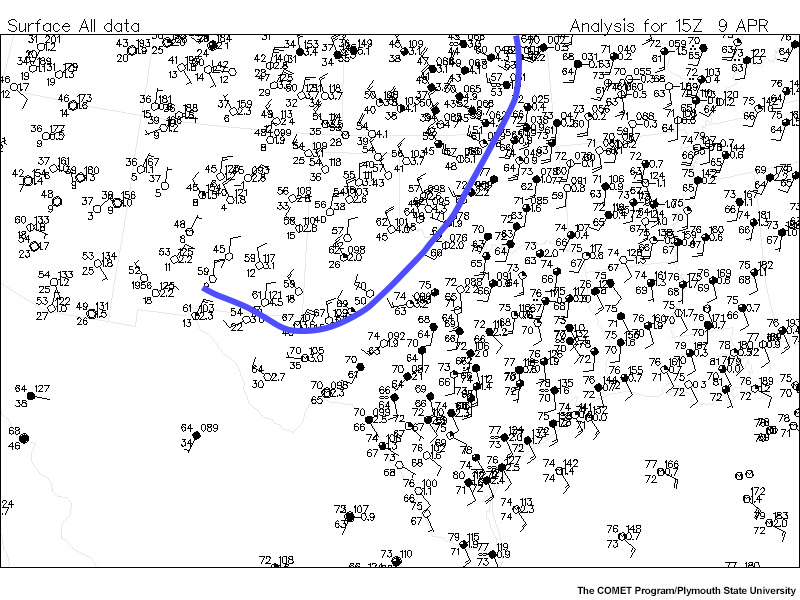Pre-Lab: Finding Fronts - Or Not! - using Single Fields
Traditionally, forecasters relied on one or more of the following fields to help define the location of a surface front: temperature, moisture, wind speed and especially direction, pressure or pressure change, and cloud cover and associated significant precipitation.
While the signatures and information discussed for each of these fields can most certainly be found in association with various types of fronts or at certain times along various fronts, the discerning forecaster should note that when used individually, these guidelines alone do not define a front! Nor are they unique to a specific type of front in a specific pattern.
Here, we cover some of the common patterns in fields available on maps of surface observations that can help you analyze and diagnose frontal position and type. In the subsequent section, we will combine these fields, as well as other observations, in order to fully determine frontal type, position and evolution.
Temperature & Potential Temperature
Surface temperature and/or potential temperature should generally be the primary determiner of frontal type and position, especially for large-scale, synoptic fronts in the midlatitudes.
To use temperature to help determine frontal type and location, one can work with surface station model plots or temperature contours of the station model plot.
Areas of significant temperature gradient should be analyzed, and their position relative to associated low pressure system, topography, etc, should be noted.
The position of the front with respect to which side of the gradient it is drawn upon will depend upon the type of front - but generally, a rule of thumb is to draw it on the warm edge of the gradient. This works for cold, warm and stationary fronts.
Question 1 of 6
Examine the following map of contoured surface temperature. Draw in the location of the main surface frontal zone using the pen tool. Be sure to choose the suggested color of the pen shown by clicking on the given colored circle in each of the following drawing questions.

| Tool: | Tool Size: | Color: |
|---|---|---|
Here we can identify a distinct zone of strong temperature gradient beginning in eastern Kansas and extending south-southwestward through central Oklahoma and western Texas. Although right now we don’t yet know what type of front exists here, we can follow the general rule that the front will be analyzed on the warm side of the gradient. An analyzed, drawn answer will appear after the question series.
Moisture
To use moisture readings to help determine frontal type and location, it is easy to work with dewpoint on surface station model plots or isodrosotherms of the station model plot.
Areas of significant dewpoint gradient should be analyzed, and their position relative to associated low pressure system, topography, etc, should be noted.
The position of the front with respect to which side of the gradient it is drawn on will depend upon the type of front - but generally, a rule of thumb is to draw it near the moist edge of the gradient. This works for cold, warm, and stationary fronts as well as drylines.
Question 2 of 6
Examine the following map of contoured dewpoint temperature. Draw in the location of the main surface frontal zone as you did in the previous map.
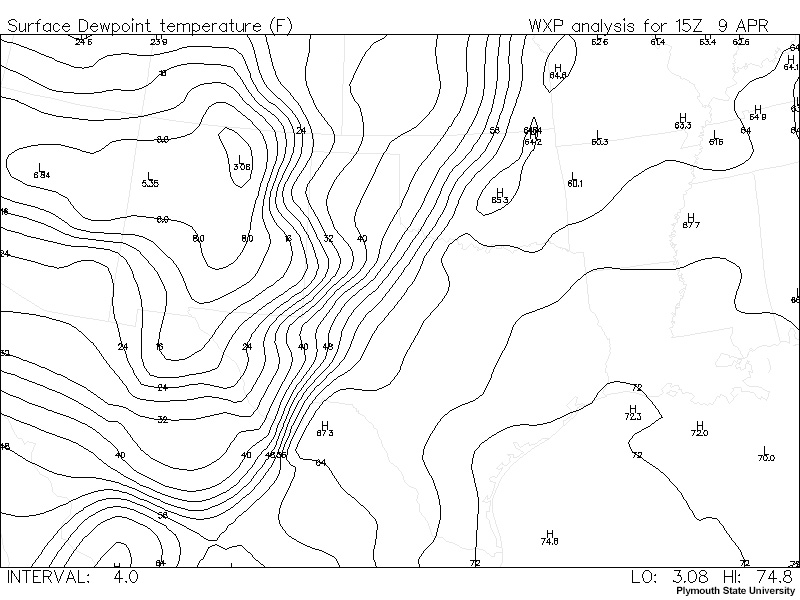
| Tool: | Tool Size: | Color: |
|---|---|---|
Here again we can identify the main frontal zone where isodrosotherms are tightly packed, beginning in eastern Kansas, extending into central Oklahoma, and then extending to western Texas. We can see that the moisture gradient remains intense even into Mexico, unlike the previous temperature map in which the temperature gradient was no longer pronounced that far south.
Winds
To use wind speed and direction to analyze frontal location, one could use wind vectors, but it is probably easiest for to use wind barbs on standard station model plot maps. The barbs provide increased accuracy in wind speed as compared to estimating vector magnitude visually by comparison to a unit vector in the key/legend.
Major synoptic-scale fronts typically exhibit a sharp change in wind direction directly at the frontal location (sometimes reminiscent of the wind change you experience as the gust front of a thunderstorm passes through). Examining wind direction also helps reinforce the user’s mental models of airmass travel and streamflow. Other fronts, such as the dryline, show a more subtle wind shift, but it is usually consistent across a large area, nonetheless.
The front should be drawn between the two areas that have large swaths of winds consistently from the same direction.
Question 3 of 6
Examine the following map of surface wind barbs. Draw in the location of the main surface frontal zone.
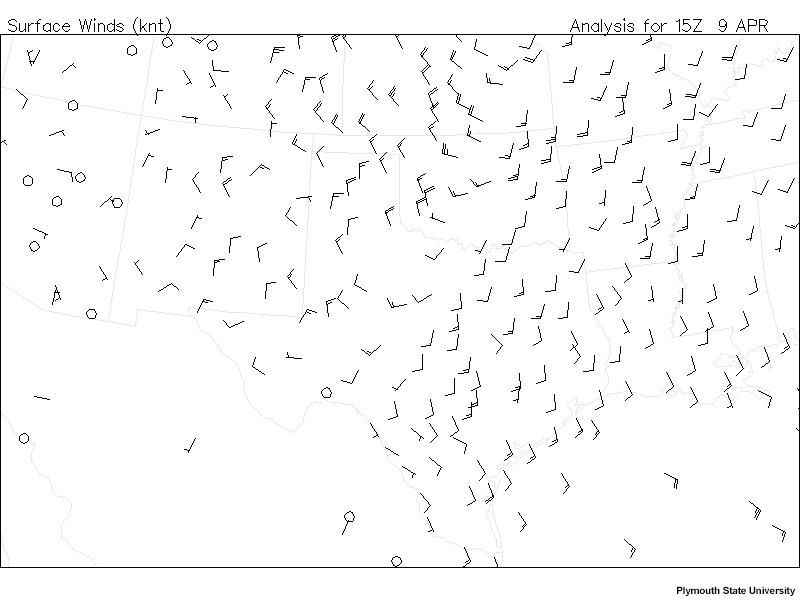
| Tool: | Tool Size: | Color: |
|---|---|---|
Here we can identify a zone of significant shift in wind direction, again in roughly the same region as the previous temperature and moisture gradients.
Pressure
Pressure can also be used to analyze fronts, as theory suggests that a first-order discontinuity in pressure should accompany a discontinuity in temperature where the front slopes upward toward cooler air. Thus, isobars crossing a front should display a kink for sharp boundaries.
In practice we don’t often see true first-order discontinuities, but rather extended zones of strong temperature gradients; thus an isobar crossing a front should be curved slightly and the front will generally be found within a slight trough (or a flat spot within a ridge). Occasionally, one will see a trough in surface pressure extended outward just along and ahead of a front due to strong low-level lifting associated with convection.
On a map, these pressure troughs in association with fronts can look like the troughs around the cold and stationary fronts extending away from the low here:
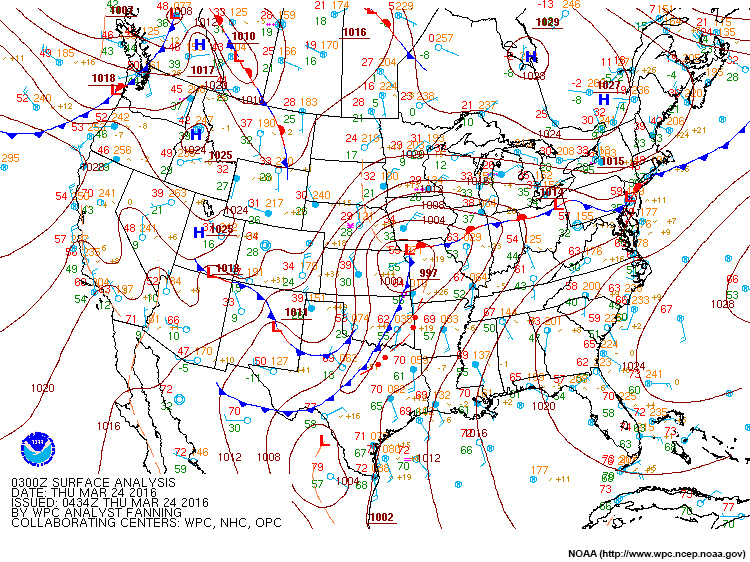
Question 4 of 6
Examine the following map of isobars. Draw in the location of the main frontal zone.
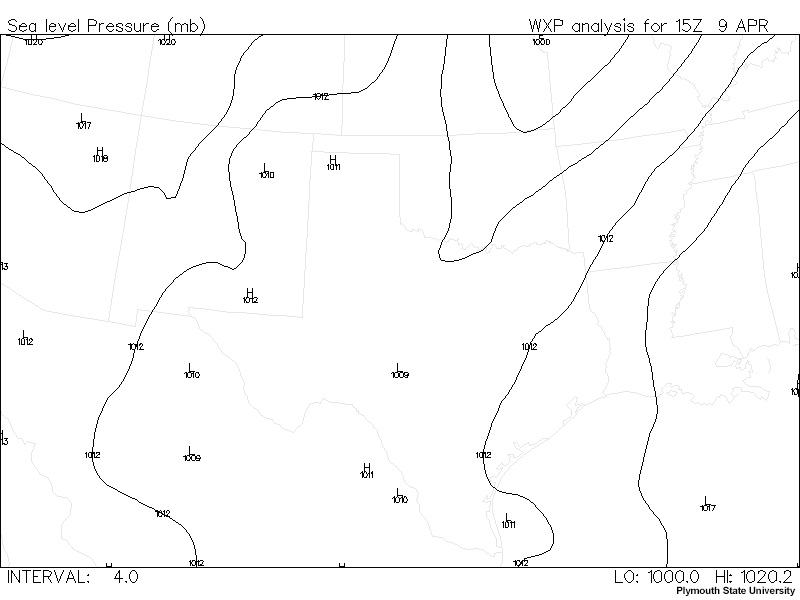
| Tool: | Tool Size: | Color: |
|---|---|---|
Here we can identify one distinct surface pressure trough, which roughly aligns with the temperature and moisture gradients identified earlier, extending through central Oklahoma and just into Texas.
Cloud Cover & Significant Weather
Cloud cover and significant weather are often cited as important indicator of frontal position, and quite often they are. But to identify frontal location solely from either of these two variables can be a guessing game. In the example below, a band of thick cloud cover and a line of convection are present along the cold front, giving away surface frontal position with a fair amount of accuracy even from space. However, what about the warm front? It doesn’t appear to have distinguishing cloud and precipitation features like the cold front - in fact, there is a very large cloud shield that covers not just the warm front, but the occluded front, northern portions of the cold front, and areas well behind the cyclone center.
This is but one of many examples. Other factors that preclude cloud cover and significant weather from being used on an individual basis to identify surface fronts include the presence of clouds and precipitation due to upper level fronts and the trowal, areas of fog, and topographically-forced precipitation and clouds away from fronts.
Let’s take a look at the frontal zone we were identifying earlier and see how the significant weather and cloud cover shape up over that area. Examine the following map of cloud cover observations.
Question 5 of 6
Draw in the location of the main frontal zone based on cloud cover.
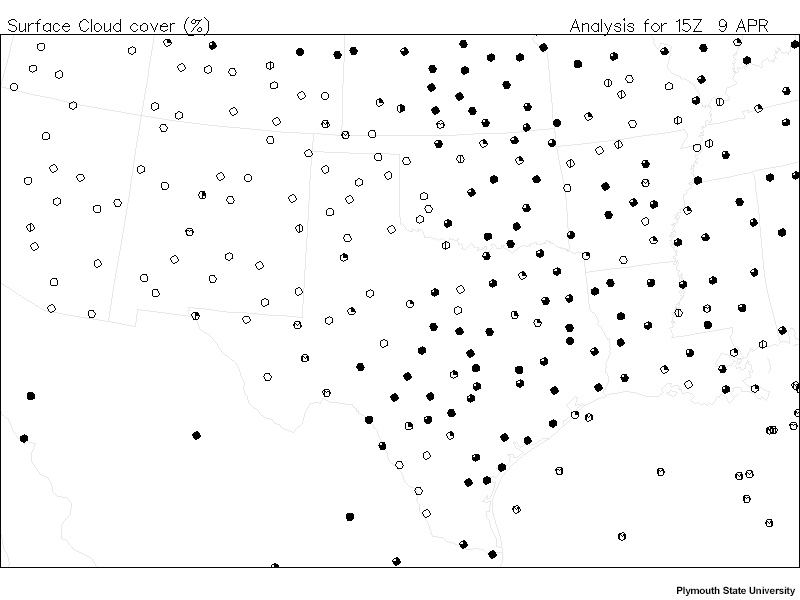
| Tool: | Tool Size: | Color: |
|---|---|---|
Here partly cloudy to overcast conditions are present along the frontal zone we identified earlier, but they extend well to the east and south of the zone itself.
Now let’s look at significant weather. Examine the following map of present weather observations.
Question 6 of 6
Draw in the location of the main frontal zone based on these observations.
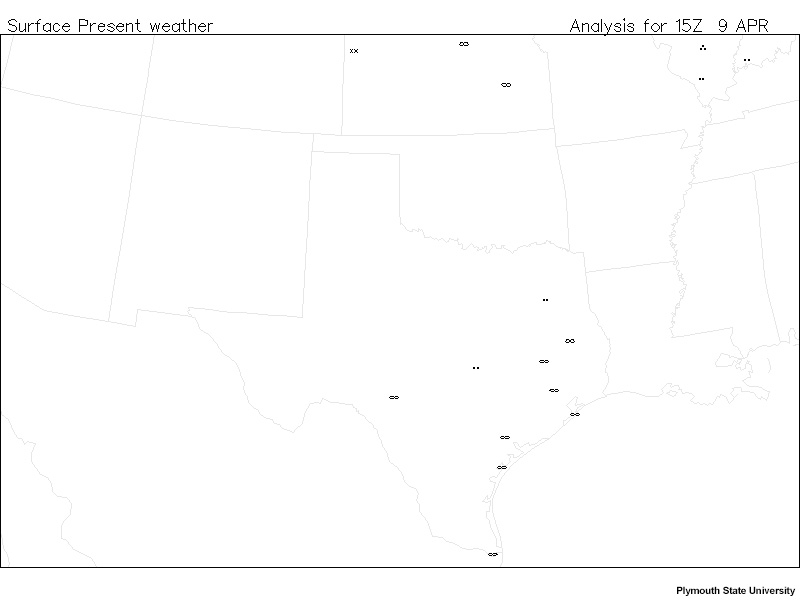
| Tool: | Tool Size: | Color: |
|---|---|---|
While one would reasonably expect some precipitation along and or just ahead of the frontal zone we identified, especially given all that cloud cover, the only significant weather we see here is haze or light rain, which is mostly coastal in SE Texas. Precipitable water, dryness of the lower troposphere (and potential evaporation/virga) all play a role in determining whether a given front will produce precipitation or not.
All Variables Together
Now that we’ve drawn in the rough location of the frontal zone, let’s take a look at all the front drawings from earlier together:
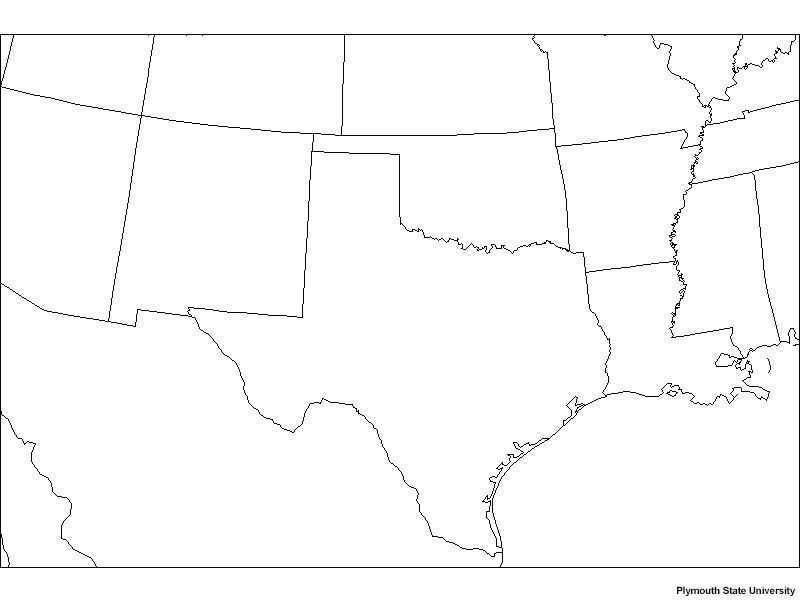
While we can see that many of the variables produced a frontal zone very close to each other, some variables were not particularly useful in this regard, especially cloud cover and significant weather. Even isotherms and isodrosotherm gradients do not necessarily outline the location of a front in exactly the same spot.
While contoured maps like the ones presented here can help train the eye on zones of strong temperature or moisture gradients, as well as pressure troughs, it is clear that we need to use all of these variables together to truly pinpoint the location of a front. Often after some “getting used to”, we can use a map of station plots to see all of these variables together and refine the frontal location.
Question 1 of 1
Determine the final location of the surface front by drawing it in with the pen tool. Available colors correspond to the standard color schemes mentioned above.
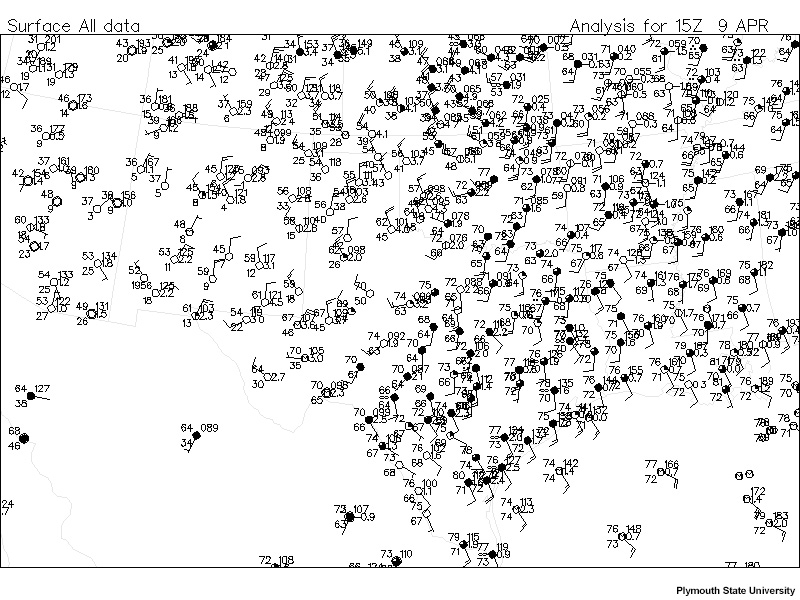
| Tool: | Tool Size: | Color: |
|---|---|---|
Now we can see the temperature and moisture gradients together, along with pressure and importantly, winds. The cold front is analyzed beginning in eastern kansas, extending through central Oklahoma and into western Texas, as before, but we can now pinpoint the location more accurately because winds are on the same map - the warm, moist flow to the east is separated from the dry, cool flow to the west by using the wind shift from southeasterly to northwesterly. The front can be drawn between the easterly component winds and westerly component ones along the line of convergence.
